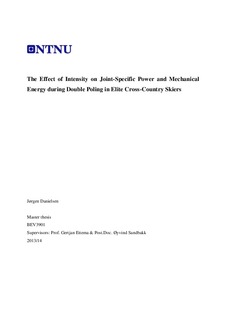| dc.description.abstract | Purpose: The present study examined the absolute behavior and the relative contributions to poling power of 1) joint-specific powers and 2) total body power (Pbody, i.e. the rate of change in total body mechanical energy) at increasing intensities while ergometer double poling.
Methods: Nine male elite skiers (body mass 81.7 ± 6.5 kg, height 1.86 ± 0.06 m) performed three 4-min submaximal trials at low (LOW), moderate (MOD), and high (HIGH) intensity, and one 3-min all-out peak test (MAX). All trials were performed standing on a force plate and the ergometer was equipped with a force cell in order measure all external forces acting on the body. Reflective markers were placed on anatomical landmarks. Kinetics and kinematics were synchronized and recorded. By applying inverse dynamics, joint-specific powers (elbow, shoulder, trunk, hip, knee and ankle) and Pbody was calculated for the poling and retrieval phase, and for the complete cycle.
Results: As net cycle poling power increased (116 ±16 W. 166 ± 36 W, 214 ± 38 W, and 306 ± 38 W at LOW, MOD, HIGH, and MAX, respectively; all p < 0.05) the relative contribution of the lower extremities increased from 39 ± 14 % at LOW to 65 ± 11 % at MAX (p < 0.05). The relative contribution of the upper extremities was stable at ~28 ± 6 %. Pbody fluctuated over the cycle, being generated during the retrieval phase (~100% of lower extremities positive power) and partly transferred to poling power during the poling phase. More specifically, Pbody was the main contributor to poling power (66 ± 13 % at LOW and 54 ± 7 % at MAX). Overall, most power was produced by the body’s core, i.e. the hip, trunk, and shoulder joints.
Conclusion: The lower extremities generate an increasing amount of Pbody during the retrieval phase, which was thereafter partly transferred to poling power during the poling phase. Enhancing the lower extremities’ work as a way of increasing Pbody during the retrieval phase seems crucial for optimal utilization of Pbody during poling phase.
Key words: double poling, biomechanics, inverse dynamics, energy, cross-country skiing | nb_NO |
